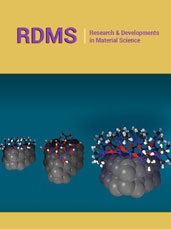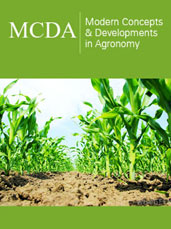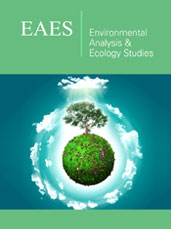- Submissions

Full Text
Clinical Research in Animal Science
Navigating Antimicrobial Use, Resistance, and Alternatives in Central and West African Livestock Production
Lovina Igele Ikwe1, Yacouba Foupouapouognigni2, Taofeeka Abayomi3, Mathieu Kaoka Djoussou4, and Wilfred Angie Abia2,5*
1Technical diagnostic Laboratory Division, Nigeria
2Laboratory of Pharmacology and Toxicology, Cameroon
3Faculty of Veterinary Medicine, Nigeria
4Faculty of Science, Cameroon
5Agri-Food Safety and One Health Agency (AFS1HA), Cameroon
*Corresponding author:Wilfred Angie Abia, Department of Biochemistry, Faculty of Science, University of Yaounde 1, BP 812, Yaounde Cameroon
Submission: November 14, 2024;Published: Janaury 31, 2025

ISSN: 2770-6729Volume 3 - Issue 4
Abstract
This review examines the complex landscape of antimicrobial use in livestock health management across Central and West Africa. It traces the historical development and current trends of antimicrobial usage in the region’s livestock sector, highlighting its critical role in disease prevention and treatment. The review explores unique challenges, including limited veterinary infrastructure, inadequate regulation, and poor surveillance systems that may contribute to antimicrobial misuse and overuse. It climaxes the growing threat of Antimicrobial Resistance (AMR) in regional livestock production, considering its potential impact on animal health, food security, and public health. The review assesses current AMR mitigation strategies and explores promising alternatives to conventional antimicrobials. By synthesizing available research and identifying knowledge gaps, this review has provided a comprehensive overview of antimicrobial use in Central and West African livestock, while proposing sustainable solutions to combat AMR. The observations underscore the need for novel approaches e.g. the One Health approach in addressing this critical issue.
Keywords:Antimicrobial resistance; Livestock health; West Africa; Central Africa; One health
Introduction
Rearing livestock is a common source of livelihood in developing countries especially in the sub-Saharan African (SSA) region contributing significantly to economic growth [1]. The SSA livestock industry faces many challenges, one of which is Antimicrobial Resistance (AMR), and its emergence has triggered lots of concern globally. This surge in AMR has been attributed to the indiscriminate usage of Antimicrobials (AMs) either for therapeutic or non-therapeutic purposes in animal production [2]. And considering farm animals as sources of food for man, indiscriminate use of AMs with potential negative health implications linked to their residues in foods e.g., when in overdose levels in animal-origin foods. However, using relatively less harmful or assumed harmless but beneficial phytogens, may be more assuring from a livestock, and one health perspective.
According to the Food and Agricultural Organization of the United Nations (FAO), AMR has been prioritized as a problem both in human and veterinary medicine and as a significant emerging threat to global public health and food security considering a large percentage of its occurrence has been attributed to consumption of food animals and their products, typifying a One Health (OH) scenario [2]. There has been a gross increase in resistant strains of bacteria over the years majorly in the SSA region and this can be a result of a lack of proper regulation in the use of AMs for animals (and even humans), inadequate surveillance systems, lack of updated AM use and treatment guidelines, lack of proper education on AM use for prescribers, tendency for animal owners to stock drugs and engaging unskilled people to treat animals and high degree of drugs abuse by livestock keepers for the sake of faster results [3,4].
With the increase in AMR trends, numerous regulatory bodies have been seeking alternatives to prevent the further emergence of resistant strains of bacteria and treatment of infections [5]. One such alternative is phytogens which are plant-based products with numerous uses from making feed more palatable to antioxidant and AMs efficacy amongst others [6].
Livestock Health
The livestock industry is a global asset and constitutes one of the major sub-sectors of agriculture, meeting humans’ nutrient needs with its products [7].
Livestock health can generally be described as the normal physiological functioning of all the body systems of livestock to achieve the highest production or the absence of disease [8]. Over the years, much concern has been directed towards livestock health as 60% of all diseases are now zoonotic and majorly of animal origin [9]. This constitutes a real menace for not only livestock health but consequentially, human health as farm animals, for the most, end up as human food with possibilities of uptake of AM residues, some of which are directly administered in man. Several factors affect livestock health thereby predisposing them to diseases. Examples of such factors are climatic conditions and genetic factors.
Climatic conditions affect animal health positively and negatively, by directly or indirectly alternating environmental conditions [7]. A direct means is by causing heat stress in animals which, can further result in metabolic disorders, suppression of the immune system, and finally death [9]. Another means is by increasing the population of disease-causing arthropods resulting in an increase in vector-borne diseases like trypanosomiasis, Q fever, and lyme diseases as high temperature promotes the reproductive cycle of insects [10]. On the other hand, climate change may indirectly affect animal (and human) health when considering potential favorable effects likely to be induced by high moisture and temperature. For example, the growth of toxigenic fungi specials, and the production of toxic secondary metabolites, mycotoxins. These toxins generally contaminate animal feeds and when animals consume mycotoxinscontaminated feeds, the toxins may have a negative effect on one or more tissues/organs such as the liver, kidney, or reproductive tract and or even trigger immunological responses making these animals vulnerable to infections [9,11,12]. Generally, such direct and indirect effects of climate change on animal health, in most cases, directly (e.g. humans like animals also suffer from the direct influence of climate change) or indirectly (such as consumption of animal-origin foods tainted with mycotoxins) translate into human health implications - a typical one health situation.
Likewise, when considering the genetic factors, animal genes contain information about the biological blueprint for its appearance, function, survival, and variation in animal behavior across species [13]. The genetics of livestock plays a huge role in influencing animal production through genetic breeding programs, also there is a lot of scientific evidence showing the significant contributions of genetics to the health and resistance of livestock to diseases [14].
Antimicrobials (History, Trends) and Roles/Uses in Livestock in Central/West Africa
History of antimicrobials (AMs)
Antimicrobials can be dated back to the 20th century when microorganisms were attributed to being responsible for human infectious diseases. Salvarsan, a remedy for syphilis, was the first AM agent to be synthesized from chemical dyes by Ehrlich in 1910. However, it had a lot of side effects. It was afterward, in 1928, that Fleming discovered Penicillin [15]. In 1935, sulfonamidochrysoidine (K1-730, Prontosil) was discovered by a group of scientists; Josef Klarer, Fritz Mietzsch, and Gerhard Domagk with sulfanilamide as the active ingredient [16]. These three AMs that were initially discovered led to further research and development of other AMs [17]
In the following decades, several AMs were developed from natural and synthetic sources. The major natural sources include microorganisms from Streptomyces spp. All these AMs were subsequently grouped into classes [18]. The main classes of AM agents are 15. In order of their discovery, they include; Arsphenamine (1910), b-Lactam (1929), Sulphonamides (1935), Polypeptides (1939), Aminoglycosides (1943), Tetracyclines (1945), Amphenicols (1947), Lipopeptides (1947), Macrolides (1950), Oxazolidones (1952), Glycopeptides (1953), Streptogramins (1953), Ansamycins (1957), Quinolones (1962) and Lincosamides (1963). In more than 50 years, a new class of AMs has not been discovered.
The usage of AM in livestock production began in 1935 in Great Britain with synthetic sulphonamides like Prontosils and other sulphonamide-like drugs which were later named ‘biological Antibiotic’ [19]. During the New York World exhibition, there was an outbreak of udder infection in cows (mastitis), and it was treated with a biological antibiotic known as gramicidin [19-21]. During the Second World War, the US became a major producer of synthetic and biological antibiotics which later brought forth the first antibiotic; Merck’s sulfaquinoxaline, officially licensed to be included in poultry feeds as treatment against coccidiosis, years after antibiotics have been routinely used for growth promotion, therapy, and prophylaxis [19,22].
Trends in am usage in livestock
In livestock, AMs are widely used to promote growth, treat infections, and treat diseases. It was estimated that about 131,109 tons of AMs were used in food animals in 2013 and is projected to rise visibly in the future [23]. Global use of AMs in food animals has been estimated at 63,151 (±1560) tons in 2010 with an estimated increase of 67% to 105,596 (±3605) tons by 2030 [24]. AMs are used heavily in Africa in livestock production, especially aminoglycosides, penicillin, and tetracycline. The percentage range of farms using AM agents is 40.6-100% in African countries; the lowest percentage was from Uganda, while Nigeria had 77.6%, and Tanzania, Cameroon, Zambia, and Egypt had 100% [3]. Presently, China and Brazil have the highest AM usage, but this is projected to decrease due to a shift in production systems in these countries [25]. However, there is a predictable rise in the percentage of AM consumption in these countries; Myanmar (205%), Indonesia (202%), Nigeria (163%), Peru (160%), and Vietnam (157%). The increase in demand for meat in low and middle-income countries, especially within Africa is likely to cause a continual rise in AM usage in livestock except with regulations and surveillance on the usage, this could lead to the generation of more Antimicrobial- Resistant Bacteria (ARB) which has deleterious effects [24].
AM uses in livestock in Central/West Africa
AMs are used in livestock in 4 main patterns: prophylaxis, metaphylaxis, treatment, and growth promotion. The usage allows for healthier and more productive animals, reduced occurrence of disease, lowered morbidity and mortality, and the production of nutritious and high-quality food in abundance for human use [26]. Therapeutic application of AMs is recommended for food animals with proper diagnosis, but non-medical use of AMs such as feed enhancers and growth promoters are more common [27]. Developed countries such as the USA and Europe have banned AMs use as growth promoters but retained the metaphylactic and prophylactic purposes [28].
In Africa, the revenue from livestock represents about 30% of the agricultural Gross Domestic Product (GDP) and 10% of the total GDP. However, the usage of AMs in African countries is largely unregulated [29]. According to the World Organization for Animal Health (WOAH), AM growth promoters have authorized usage in 15% of African countries. In some states of southwestern Nigeria, the main AMs used were tetracyclines, fluoroquinolones, and b-Lactam/aminoglycosides [30]. These AMs were also reported to be used in Ghana mainly for preventing and treating infections [31]. In Rwanda, a central African country, a high proportion of antibiotics are used in food animals for mostly prophylaxis and the farmers that use it have limited expertise [32]. A major factor that contributes to the usage is the easy access to drugs through retailers, vendors, veterinarians, etc. Guidelines by WHO instruct member states to reduce veterinary antimicrobial use to curb this practice and forestall residues in food animals (WHO guidelines, 2017).
AM challenges/limitations in Central/West Africa
Antimicrobials misuse
Antimicrobials (AMs) are greatly misused, particularly in sub- Saharan Africa [4,33,34]. The misuse and overuse of AM across multiple sectors; human, agricultural, and animal is responsible for the emergence of resistant microorganisms [35]. This is also identified as the major driver of AMR (Moussa and Garba, 2022). Situations that define AM misuse include; unregulated sales of such drugs, self-administration of AMs without proper diagnosis, underdosing, over-dosing, non-compliance with AM withdrawal periods in food animals and failure to complete the course of the drug (Nma et al., 2022). Countries in Africa misuse AMs partly due to socioeconomic factors such as poor enforcement of laws to regulate sales of AMs, lack of sensitization in the community, inadequate human medical care and veterinary services, poverty, etc.
There is a low level of awareness about what constitutes AM misuse among livestock farmers [33,36] companion animal owners and even veterinarians [35]. Health promotion and public health programs can help to spread awareness amongst these persons and alleviate such misuse.
Antimicrobial Resistance (AMR)
Today, AMR is a global health crisis that has impeded the ability of the “wonder drug” to treat multiple infections [35]. In the United States, over 2 million infections and approximately 23000 deaths each year are attributed to AMR organisms. In Europe, this is associated with about 25000 deaths annually (Marston, 2016). Though the documentation is poor, it is reported that there is a high prevalence of AMR pathogens in Africa [37]. The most common class of AMs used in food animal production is tetracyclines. Sulfonamides and penicillin had the highest resistance rates alongside erythromycin, ciprofloxacin, and cephalosporins used in humans.
The emergence of resistant bacteria was due to the widespread use of AMs in food animals, AMR in animals started when farmers were allowed to administer antibiotics even without appropriate veterinary prescription. This led to continuous overdose, underdose, or abuse sub-therapeutically by these farmers who wanted high production. This resulted in certain bacterial deaths, and those that remain develop resistant genes. This usage leads to residues within the animals which could be transmitted to humans via the environment and direct contact [24]. Staphylococcus aureus is the most familiar AMR bacteria and dates back to as early as 1961 when it developed a resistance to Methicillin [15]. Methicillin-resistant S. aureus (MRSA) is a clinical infection that has caused a lot of concern in the past years because of its fatality and health burden [35]. Other microorganisms such as Salmonella spp, Campylobacter spp, and Escherichia coli have developed significant resistant mechanisms towards certain AMs. These microorganisms commonly produce infections in both humans and animals. The increased usage of AMs previously used for humans in animals may be attributed as a major factor causing AMR.
Clinical diagnosis
Poor diagnosis is one of the factors that worsens the effect of AMR. In Africa, the facilities for healthcare institutions are severely lacking and this prompts self-medication and sales of drugs by unauthorized persons [38]. Inaccurate diagnosis leads to overprescribing which also promotes AMR. There is a high prevalence of counterfeit AM drugs being sold in Africa. This is because there is a lot of demand therein causing an influx of fake drugs that don’t work.
Regarding the time required to identify and characterize microbial pathogens, it is expensive to take a course for several days to weeks [39]. Clinicians then prescribe tentative AM therapies for various patients before a diagnosis can be confirmed. This practice further exacerbates AMR. Improved diagnostic facilities, especially using Rapid Diagnostic Tests (RDT) are necessary to combat resistant microorganisms. With RDT, there is reduced mortality, length of hospital stays and healthcare costs. This promotes costeffectiveness and alleviates the usage of AMs.
Cost
The cost of AMR is huge. It has led to great adverse effects on One Health. The costs incurred are not only monetary, but they also cause emotional trauma, pain, treatment complications, patient mortality and morbidity, healthcare systems dysfunction, and economic damage. Unfortunately, it has been projected to be on the rise. The burden of infections with selected ARBs of public health importance annually was estimated to have over doubled across European Union/European Economic Area (EU/EEA) countries between 2007 to 2015 [40].
Resistant infections significantly increase healthcare costs. In the United States, the estimated cost of treatment for resistant infections is USD 10000 - 40000 higher than for susceptible infections [41]. The severity of the infections could then determine other costs such as poor prognosis, long treatment duration, and complications.
The adverse effect on the economy is due to the reduction in labor market productivity and the size of the working population. In 31 European countries, an estimated number of over 3000 deaths resulting in a cost of €62 million was caused by MRSA and resistant E. coli [42,43]. The World Bank projects that, by 2050, AMR impact would result in a reduction in Gross Domestic Product (GDP) by 1.1%-3.8%, an increased poverty level with up to 28.3 million persons becoming poorer, a decline in livestock production in lowincome countries by 1.1%, reduced trade exports and increased healthcare expenditures across low-income, middle-income and high-income countries [44].
Potential AMR adaptation, mitigation strategies, and AM alternatives
AMR adaptation strategies
Adaptation strategies are designed to adjust or adapt to a present situation and future effects. Similar to climate change, there are adaptation strategies that could help cope with the influence of AMR. Already, several plans and strategies have been drawn out to combat AMR.
In 2011, the European Strategic Action Plan on Antibiotic Resistance was established to assist member countries in mitigating the effects of AMR [45]. Through this plan, recommendations were made that have been adopted by other countries. The Transatlantic Task Force on Antimicrobial Resistance (TATFAR) was also founded to facilitate cooperation between the European Union and the United States in the fight against AMR. The World Health Organization (WHO) Global Antimicrobial Resistance and Use Surveillance System (GLASS) was introduced in 2015 to promote the surveillance of AMR [46]. Other organizations such as the FAO and World Organization for Animal Health (formerly OIE, now WOAH) have developed action plans and strategies on AMR respectively.
Potentially, vaccination could be employed as an adaptive measure. It can prevent infectious diseases, reduce the incidents of viral infections, and prevent diseases that have become difficult to treat [47]. All these reduce antibiotic use. Adherence to vaccination schedules especially for vaccines of interest such as Typhoid Vaccine (TCV), Pneumococcal vaccines (PCV), Haemophilus influenzae type B (Hib), Influenza, etc. is suggested [37,48].
AMR surveillance is employed as a public health measure to control the effects of AMR. The drivers and burden of AMR can be determined through data gathering and monitoring, surveys, and research studies [46]. This could be a possible adaptive strategy as such data can inform health practitioners and stakeholders on high-risk pathogens to be monitored, AM to be restricted due to high consumption, and the development of policies to promote rational use of AM.
AMR mitigation strategies
Mitigation strategies are established to prevent or reduce the occurrence of a situation. To prevent AMR, measures such as novel AM development, targeting ARB using alternative strategies, and promoting optimal use of AM can be employed.
Interdisciplinary and multisectoral efforts have been used to mitigate the effects of AMR. It is already in place with stakeholders drawn from public health, human and veterinary medicine, and agriculture. To boost the efficiency of such efforts, further stakeholder analysis should be done and more stakeholders should be involved [49].
According to Anderson et al. [40] the quality of AMR national action plans (NAPs) is not consistent and some essential areas or objectives should be targeted in formulating a national strategy for AMR. These areas include ‘Increasing awareness of AMR through the public, Strengthening surveillance and monitoring and moving towards national One Health surveillance systems, Strengthening AM stewardship in human health, Strengthening Infection Prevention and Control (IPC) in human health, Strengthening IPC and reducing inappropriate antibiotic use in animals, Limiting the exposure of AM-resistant pathogens to the environment and fostering Research and Development (R&D) of new AM therapies, diagnostics and vaccines’.
However, in Africa, there is a dearth of AMR strategies largely due to poor implementation, lack of proper AM treatment guidelines, and the absence of well-trained professionals. It is reported that out of 23 African member states under GLASS, only 15 have shared data on the surveillance system. Individual countries have NAPs for AMR [50] to join efforts in reducing the effects. Again, reports show that Kenya, Burkina Faso, Nigeria, Côte d’Ivoire, Mozambique and South Africa are the only African countries out of 36 with NAPs that are actively monitoring and implementing their NAPs. All these show the extent to which intervention is needed to assist in the fight against AMR in Africa due to the shortfalls.
Potential AM alternatives
One of the solutions offered for the AMR issue is the use of a combined therapy of a specific antibiotic and an antibiotic adjuvant [51]. The combination of Amoxicillin and Clavulanic acid is a successful example of synergistic drug effects. Adjuvants work to enhance the antibiotic’s effect thereby reducing its blocking resistance. The major types of antibiotic adjuvants include betalactamase inhibitors, efflux pump inhibitors, and outer membrane permeabilizers. Another is the use of the genome editing system; the CRISPR/cas system for the development of new AMs. The AMs would be developed to target specific pathogens using phage vectors [52]. Endolysins from bacteriophages such as Artilysin have been used to target specific microbes e.g. Pseudomonas aeruginosa, and Acinetobacter baumannii [53].
Nowadays, potential novel strategies to address AMR may require eco-centric/One Health approaches. The One Health approach emphasizes the interconnectedness of environmental, animal and human health [54,55]. Addressing AMR within the One Health framework requires innovative strategies. For example, phytogens may be explored as suitable candidates as alternatives for AMs as they naturally possess AM properties that can combat pathogens without inducing resistance. Phytogens have been revealed to offer a promising alternative to traditional AMs [56-58].
Integrating phytogens aligns with One Health principles by promoting sustainable solutions that benefit animal and human health while mitigating environmental impact. By reducing reliance on conventional AM, this approach curtails the risk of AMR spread across species and ecosystems. Additionally, implementing phytogens necessitates interdisciplinary collaboration among agricultural, veterinary, and healthcare sectors, fostering a holistic or unifying approach to disease prevention [59,60]. A convergence of research, education, and policy measures to support this transition, emphasizing prudent use and harnessing nature’s potential cannot be overemphasized. Furthermore, embracing phytogens within the One Health framework not only combats AMR but also underscores the interconnectedness of health domains, advocating for a harmonious balance between human, animal, and environmental well-being [61-64].
Conclusion and Prospects
The use of antimicrobial agents in livestock production in Central/West Africa faces significant challenges, including limited regulation, poor surveillance, and inadequate awareness among stakeholders. AMR poses a growing threat to animal and human health in the region. To address these issues, a multifaceted approach is necessary. This should include strengthening regulatory frameworks, improving surveillance systems, enhancing education and training for farmers and veterinarians, promoting responsible antimicrobial use, and investing in alternative disease prevention strategies e.g. use of phytogens. Additionally, adopting a One Health approach that recognizes the interconnectedness of human, animal, and environmental health is crucial.
Declarations
Ethical statement
The authors confirm that the ethical policies of the journal, as noted on the journal’s author guidelines page, have been adhered to. No ethical approval was required as this is a review article with no original research data.
Data availability statement
Data sharing not applicable to this article as no datasets were generated or analysed during the current study
Authors’ contributions
WAA conceived the idea and designed the outline of the manuscript. LII and WAA did desktop-based research and writing. LII, TA, MKD, and WAA proofread the manuscript. All authors read and approved the final manuscript.
References
- Herrero M, Grace D, Njuki J, Johnson N, Enahoro D, et al. (2012) The roles of livestock in developing countries. Animal: An International Journal of Animal Bioscience 7(Suppl 1): 3-18.
- Wall BA, Mateus A, Marshall L, Pfeiffer D, Lubroth J, et al. (2016) Drivers, dynamics and epidemiology of antimicrobial resistance in animal production, Food and Agriculture Organization of the United Nations.
- Kimera ZI, Mshana SE, Rweyemamu MM, Mboera LEG, Matee MIN (2020) Antimicrobial use and resistance in food-producing animals and the environment: an African perspective. Antimicrobial Resistance & Infection Control 9(1): 37.
- Tebug SF, Abia WA, Tebug TT, Teno G, Mouiche MMM (2022) Veterinary drug residues in animal-derived foods: occurrence, veterinary legislation and perceived risk factors in Cameroon. Multidisciplinary Science Journal 4(3): 2022012.
- Ghosh C, Sarkar P, Issa R, Haldar J (2019) Alternatives to conventional antibiotics in the era of antimicrobial resistance. Trends in Microbiology 27(4): 323-338.
- Windisch W, Schedle K, Plitzner C, Kroismayr A (2008) Use of phytogenic products as feed additives for swine and poultry. Journal of Animal Science 86(14 Suppl): 140-148.
- Abubakar M, Iqbal A, Manzoor S, Javed Arshed M (2020) Introductory chapter: Livestock health and farming-regional to global perspectives. In: Abubakar M (Ed.), Livestock Health and Farming, Intech Open, London, UK, pp. 3-9.
- Ducrot C, Bedhom B, Béringue V, Coulon JB, Fourichon C, et al. (2011) Issues and special features of animal health research. Veterinary Research 42(1): 96.
- Lacetera N (2018) Impact of climate change on animal health and welfare. Animal Frontiers: The Review Magazine of Animal Agriculture 9(1): 26-31.
- Al-Amin AQ, Alam GM (2011) The impacts of climate change on animal health and economy: A way forward for policy option. Asian Journal of Animal and Veterinary Advances 6(11): 1061-1068.
- Abia WA, Simo GN, Warth B, Sulyok M, Krska R, et al. (2013) Determination of multiple mycotoxins levels in poultry feeds from Cameroon. The Japanese Journal of Veterinary Research 61: S33-S39.
- Bernabucci U, Colavecchia L, Danieli PP, Basiricò L, Lacetera N, et al. (2011) Aflatoxin B1 and fumonisin B1 affect the oxidative status of bovine peripheral blood mononuclear cells. Toxicology in vitro 25(3): 684-691.
- Food and Agriculture Organization of the United Nations (2014) Animal Genetics.
- Berry DP, Bermingham ML, Good M, More SJ (2011) Genetics of animal health and disease in cattle. Irish Veterinary Journal 64(1): 5.
- Powers JH (2004) Antimicrobial drug development- the past, the present, and the future. Clinical Microbiology and Infection 10(Suppl 4): 23-31.
- Domagk G (1935) A contribution to the chemotherapy of bacterial infections. DMW - Deutsche Medizinische Wochenschrift (German Medical Weekly) 61: 250-253.
- Aminov RI (2010) A brief history of the antibiotic era: lessons learned and challenges for the future. Frontiers in Microbiology 1: 134.
- Aminov R (2017) History of antimicrobial drug discovery: Major classes and health impact. Biochemical Pharmacology 133: 4-19.
- Kirchhelle C (2018) Pharming animals: a global history of antibiotics in food production (1935–2017). Palgrave Communications 4: 96.
- Mulchinock WJ (1942) Gramicidin in mastitis therapy. Canadian Journal of Comparative Medicine and Veterinary Science 6(4): 95-101.
- Bud R (2007) Penicillin: triumph and tragedy. Oxford University Press, New York, USA.
- Lesch JE (2007) The first miracle drugs: how the sulfa drugs transformed medicine, Oxford University Press, New York, USA.
- Pokharel S, Shrestha P, Adhikari B (2020) Antimicrobial use in food animals and human health: time to implement ‘One Health’approach. Antimicrobial Resistance & Infection Control 9(1): 181.
- Van Boeckel TP, Brower C, Gilbert M, Grenfell BT, Levin SA, et al. (2015) Global trends in antimicrobial use in food animals. Proceedings of the National Academy of Sciences 112(18): 5649-5654.
- Ibrahim M, Ahmad F, Yaqub B, Ramzan A, Imran A, et al. (2020) Current trends of antimicrobials used in food animals and aquaculture. In: Hashmi MZ (Ed.), Antibiotics and Antimicrobial Resistance Genes in the Environment, Elsevier, Netherlands, pp. 39-69.
- Page S, Gautier P (2012) Use of antimicrobial agents in livestock. Revue Scientifique et Technique-OIE 31(1): 145-188.
- Van TTH, Yidana Z, Smooker PM, Coloe PJ (2020) Antibiotic use in food animals worldwide, with a focus on Africa: Pluses and minuses. Journal of Global Antimicrobial Resistance 20: 170-177.
- Woolhouse M, Ward M, Van Bunnik B, Farrar J (2015) Antimicrobial resistance in humans, livestock and the wider environment. Philosophical transactions of the Royal Society of London. Series B, Biological Sciences 370(1670): 20140083.
- Mensah SE, Koudandé OD, Sanders P, Laurentie M, Mensah GA, et al. (2014) Antimicrobial residues in foods of animal origin in Africa: public health risks. Revue Scientifique et Technique 33(3): 987-996.
- Adesokan HK, Akanbi IM, Akanbi IO, Obaweda RA (2015) Pattern of antimicrobial usage in livestock animals in south-western Nigeria: The need for alternative plans. Onderstepoort Journal of Veterinary Research 82(1): 816.
- Boamah VE, Agyare C, Odoi H, Dalsgaard A (2016) Practices and factors influencing the use of antibiotics in selected poultry farms in Ghana. Journal of Antimicrobial Agents 2: 120.
- Manishimwe R, Nishimwe K, Ojok L (2017) Assessment of antibiotic use in farm animals in Rwanda. Tropical Animal Health and Production 49(6): 1101-1106.
- Tebug SF, Mouiche MMM, Abia WA, Teno G, Tiambo CK, et al. (2021) Antimicrobial use and practices by animal health professionals in 20 sub-Saharan African countries. Preventive Veterinary Medicine 186: 105212.
- Smith PW, Agbaje M, LeRoux-Pullen L, Van Dyk D, Debusho LK, et al. (2019) Implication of the knowledge and perceptions of veterinary students of antimicrobial resistance for future prescription of antimicrobials in animal health, South Africa. Journal of the South African Veterinary Association 90(0): 1-8.
- McEwen SA, Collignon PJ (2018) Antimicrobial resistance: a one health perspective. Microbiology Spectrum 6(2): 10.
- Alhaji NB, Isola TO (2018) Antimicrobial usage by pastoralists in food animals in North-central Nigeria: The associated socio-cultural drivers for antimicrobials misuse and public health implications. One Health 6: 41-47.
- Van Heuvel L, Caini S, Dückers ML, Paget J (2022) Assessment of the inclusion of vaccination as an intervention to reduce antimicrobial resistance in AMR national action plans: a global review. Globalization and Health 18(1): 85.
- Okeke IN, Aboderin OA, Byarugaba DK, Ojo KK, Opintan JA (2007) Growing problem of multidrug-resistant enteric pathogens in Africa. Emerging Infectious Diseases 13(11): 1640-1646.
- Kaprou GD, Bergšpica I, Alexa EA, Alvarez-Ordóñez A, Prieto M (2021) Rapid Methods for Antimicrobial Resistance Diagnostics. Antibiotics 10(2): 209.
- Anderson M, Clift C, Schulze K, Sagan A, Nahrgang S, et al. (2019) Averting the AMR crisis: What are the avenues for policy action for countries in Europe? European Observatory on Health Systems and Policies, Policy Brief, No. 32.
- Tansarli GS, Karageorgopoulos DE, Kapaskelis A, Falagas ME (2013) Impact of antimicrobial multidrug resistance on inpatient care cost: an evaluation of the evidence. Expert Review of Anti-infective Therapy 11(3): 321-331.
- de Kraker MEA, Wolkewitz M, Davey PG, Koller W, Berger J, et al. (2011a) Burden of antimicrobial resistance in European hospitals: excess mortality and length of hospital stay associated with bloodstream infections due to Escherichia coli resistant to third-generation cephalosporins. Journal of Antimicrobial Chemotherapy 66(2): 398-407.
- de Kraker MEA, Wolkewitz M, Davey PG, Koller W, Berger J, et al. (2011b) Clinical impact of antimicrobial resistance in European hospitals: excess mortality and length of hospital stay related to methicillin-resistant Staphylococcus aureus bloodstream infections. Antimicrobial Agents and Chemotherapy 55(4): 1598-1605.
- World Bank (2017) Drug-resistant infections: A threat to our economic future. Washington DC: World Bank Group; Final report.
- Gulumbe BH, Haruna UA, Almazan J, Ibrahim IH, Faggo AA, et al. (2022) Combating the menace of antimicrobial resistance in Africa: A review on stewardship, surveillance and diagnostic strategies. Biological Procedures Online 24(1): 1-13.
- World Health Organization, WHO (2021) Global Antimicrobial Resistance and Use Surveillance System (GLASS) Report 2021, Geneva, Switzerland.
- World Health Organization, WHO (2015) Global action plan on antimicrobial resistance, Geneva, Switzerland.
- World Health Organization, WHO (2020) Leveraging vaccines to reduce antibiotic use and prevent antimicrobial resistance: an Action Framework, Geneva, Switzerland.
- Majowicz SE, Parmley EJ, Carson C, Pintar K (2018) Identifying non-traditional stakeholders with whom to engage, when mitigating antimicrobial resistance in foodborne pathogens (Canada). BMC Research Notes 11(1): 170.
- World Health Organization, WHO (2022) Library of AMR national action plans, Geneva, Switzerland.
- Annunziato G (2019) Strategies to overcome Antimicrobial Resistance (AMR) making use of non-essential target inhibitors: A review. International Journal of Molecular Sciences 20(23): 5844.
- Bikard D, Euler CW, Jiang W, Nussenzweig PM, Goldberg GW, et al. (2014) Exploiting CRISPR-Cas nucleases to produce sequence-specific antimicrobials. Nature Biotechnology 32(11): 1146-1150.
- Defraine V, Schuermans J, Grymonprez B, Govers SK, Aertsen A, et al. (2016) Efficacy of Artilysin Art-175 against resistant and persistent acinetobacter baumannii. Antimicrobial Agents and Chemotherapy 60(6): 3480-3488.
- Buttke DE (2011) Toxicology, environmental health, and the "One Health" concept. Journal of Medical Toxicology 7(4): 329-332.
- Von Borries R, Guinto RR, Thomson DJ, Abia WA, Lowe R (2020) Planting sustainable seeds in young minds: The need to teach planetary health to children. The Lancet Planetary Health 4(11): 501-502.
- Savoia D (2012) Plant-derived antimicrobial compounds: alternatives to antibiotics. Future Microbiology 7(8): 979-990.
- Bajagai YS, Alsemgeest J, Moore RJ, Van TT, Stanley D (2020) Phytogenic products, used as alternatives to antibiotic growth promoters, modify the intestinal microbiota derived from a range of production systems: an in vitro Applied Microbiology and Biotechnology 104(24): 10631-10640.
- AlSheikh HMA, Sultan I, Kumar V, Rather IA, Al-Sheikh H, et al. (2020) Plant-based phytochemicals as possible alternative to antibiotics in combating bacterial drug resistance. Antibiotics 9(8): 480.
- Amuasi JH, Lucas T, Horton R, Winkler AS (2020) Reconnecting for our future: The lancet one health commission. The Lancet 395(10235): 1469-1471.
- Mackenzie JS, Jeggo M (2019) The one health approach-why is it so important? Tropical Medicine Infectious Diseases 4(2): 88.
- Perry B, Grace D (2009) The impacts of livestock diseases and their control on growth and development processes that are pro-poor. Philosophical transactions of the Royal Society of London. Series B, Biological sciences 364(1530): 2643-2655.
- Alhaji N, Adamu A, Odetokun I, Lawan M, Fasina FO (2022) Practices of antimicrobial usage and associated resistance emergence in smallholder beef cattle production systems in Northern Nigeria: Drivers and One Health challenge.
- Gelband H, Miller-Petrie M, Pant S, Gandra S, Levinson J, et al. (2015) The state of the world’s antibiotics, 2015, (Center for Disease Dynamics, Economics & Policy, Washington), USA, pp. 7-14.
- Van Boeckel TP, Pires J, Silvester R, Zhao C, Song J, et al. (2019) Global trends in antimicrobial resistance in animals in low-and middle-income countries. Science 365(6459): eaaw1944.
© 2025 Wilfred Angie Abia. This is an open access article distributed under the terms of the Creative Commons Attribution License , which permits unrestricted use, distribution, and build upon your work non-commercially.
 a Creative Commons Attribution 4.0 International License. Based on a work at www.crimsonpublishers.com.
Best viewed in
a Creative Commons Attribution 4.0 International License. Based on a work at www.crimsonpublishers.com.
Best viewed in 







.jpg)






























 Editorial Board Registrations
Editorial Board Registrations Submit your Article
Submit your Article Refer a Friend
Refer a Friend Advertise With Us
Advertise With Us
.jpg)






.jpg)














.bmp)
.jpg)
.png)
.jpg)










.jpg)






.png)

.png)



.png)






